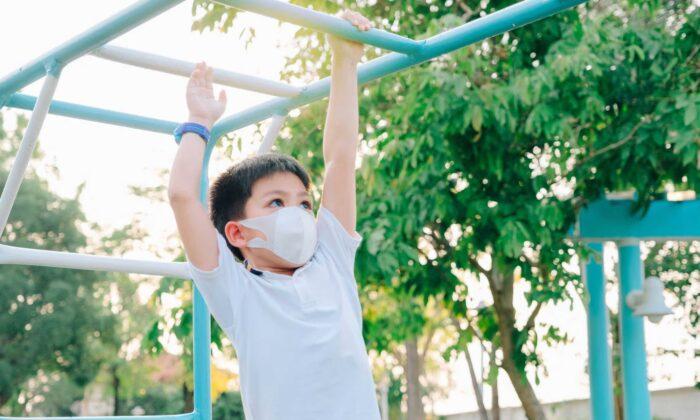Many public health responses we saw during the pandemic were inherently unethical, but our flippancy concerning child safety in public schools has been among the most egregious. Sadly, families remain largely resourceless against power-hungry leadership.
Masking remains an issue hotly debated at school board meetings around the globe. In Ontario, Canada, on Nov. 24, 2022, a district-wide mask mandate was narrowly avoided by a 6-6 vote. While parents were relieved, it was too close for comfort.
It begs repeating, and with great emphasis, that every mask you have ever seen on a child is unregulated, untested, and unsafe, with zero efficacy, fit, term of wear, or medical clearance standards. Zero.
Were a student critically injured while on campus, medical professionals would make relevant decisions until a parent was present, never asking a teacher, principal, or superintendent to make health care choices. Were a teen to fall pregnant, a teacher cannot consent to an abortion in place of a parent. A school nurse is a caregiver, not a guardian. This is a line we cannot allow to be blurred.
We skipped that necessary medical clearance and consent arm of respiratory protection with children. We require rigorous safety standards from all other child-related products. Why would we ignore safety protocols for something with known, anticipated harms?
Simply calling something unethical is a far cry from proving it to be so. By mapping out the specific details of demands like compulsory masking, we can push for these practices to be argued before Institutional Review Boards (IRB) for human studies to prove the unethical nature of our policies. I created a replica study of school-based masking practices for doctors to bring before their IRBs, the correct domain for such a debate, as opposed to school board meetings. Perhaps we can finally put an end to these inhumane practices before things escalate to irreversible harm.
I had a doctor argue my replica study before her IRB in Arizona, and it was unanimously rejected based on extensive ethical violations and anticipation of harm.
From the IRB meeting minutes, “A study was brought before this IRB. It was noted that the proposed study would introduce risk to children. It seemed to the group that we are rejecting this on the basis of violation of First Do No Harm. There would be no medical supervision during this time, even if children were severely impacted physiologically during wear. Frightening. A motion was made: Reject this study because the children would not be assessed medically, and it violates Primum non nocere. And it is unethical. The motion was seconded. The motion then passed by unanimous vote to reject this study on ethical grounds.”
Replica Study (Exact Wording as Presented)
In a proposed replica study of what schoolchildren are experiencing on a daily basis due to mandated masking, a few design elements would be critical.The masks seen on children are unregulated, untested, and without efficacy standards for particle grade. There exist no fit or safety standards for extended wear, no qualitative fit testing as is standard with workplace apparatus requirements, and no monitoring of health status including physiologically impacting interferences such as deoxygenation, hypercapnia, or linguistic and developmental interferences from being unable to see tooth, tongue, and lip placement. The apparatuses seen on children are expressly non-mitigating for aerosols by OSHA and NIOSH standards, wherein an apparatus must be 90 percent effective to be considered mitigating and 3.2 percent leakage equates to 100 percent inefficacy for aerosol exposure.
So in a study focused on child participants, the behavioral ramifications of noncompliance would need to be universal; noncompliance for wearing the apparatus would result in punishment such as the loss of preferred activities or running laps masked during recess, as is commonplace in our school systems.
Oxygen levels could be monitored, but children would be required to wear them even if their oxygen levels decrease to unsafe levels during wear (as there has been no health monitoring provided in schools).
Children in school systems wear masks for 8-12 hours per day, so in summary, we would have unregulated apparatuses on children with no medical clearance or parental consent, with no regard given for deoxygenation or hypercapnia observed in study participants, harsh penalties for noncompliance, and exposure to dangerous pathogens directly in front of oral and nasal mucosa in a warm, moist environment prime for biological amplification for 8-12 hours per day. It would be important to show the longitudinal impact of physiological and developmental interferences, so the study would need to be at least one year minimum.

Considerations
If our leadership took public health messaging seriously, they would be painstakingly specific when educating the public during a crisis. For the medically vulnerable, we must prevent instilling a false sense of security, especially when following a given measure will likely result in susceptible individuals being harmed or killed.Have those pushing increasingly restrictive apparatuses on children even stopped to consider the reality of what children are experiencing on a minute-by-minute basis? Children depend on us to provide safe educational settings, with make-believe reserved for play, absent from our methods of protecting the medically vulnerable. Yet in terms of schools and proper mitigation efforts, we failed them all.




